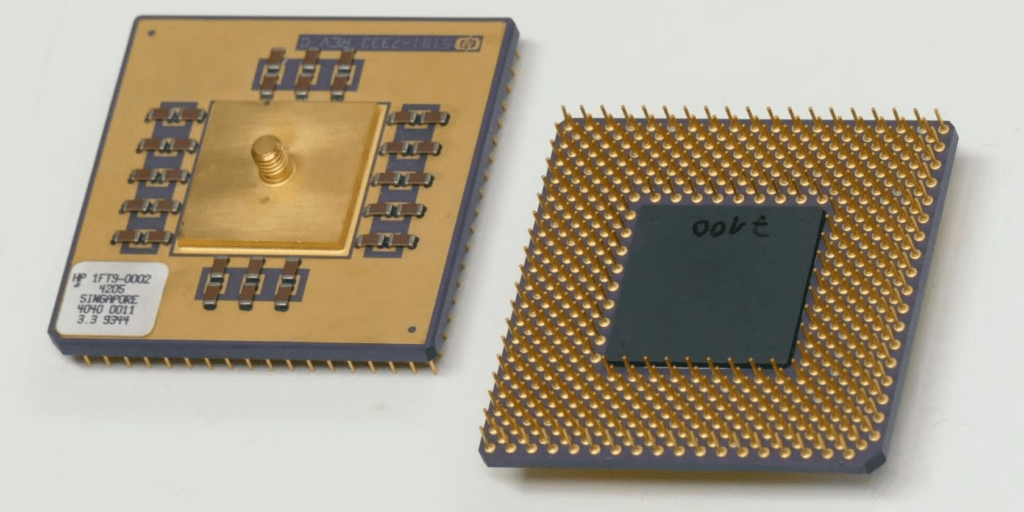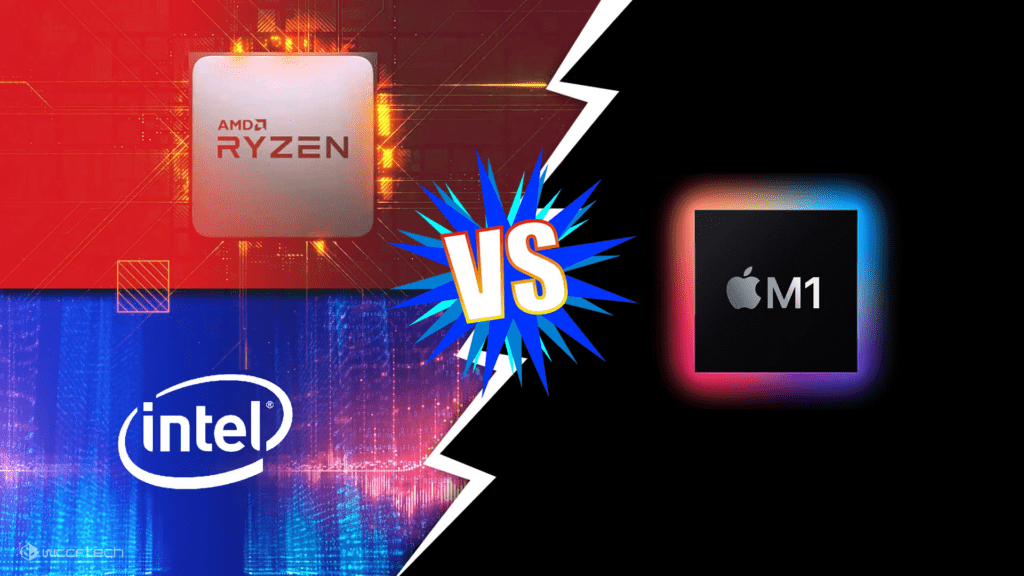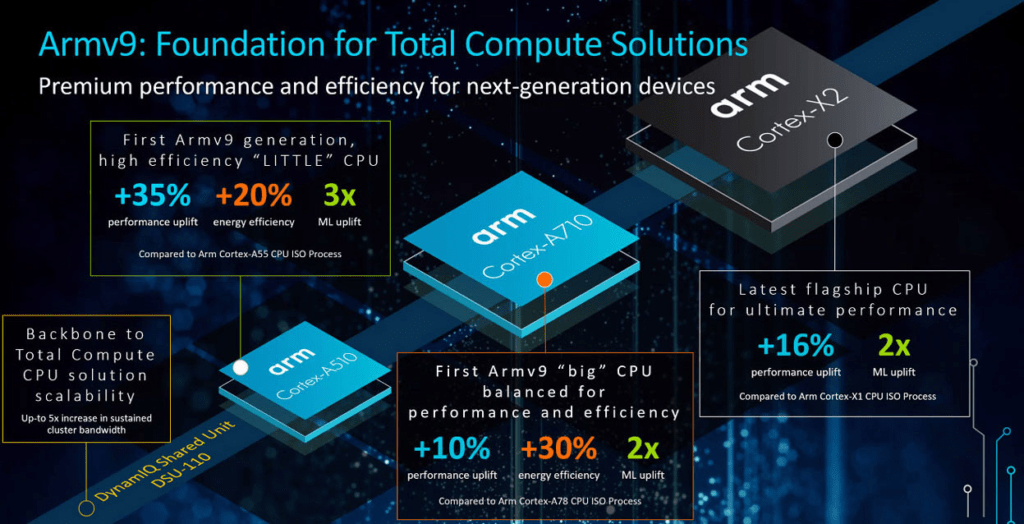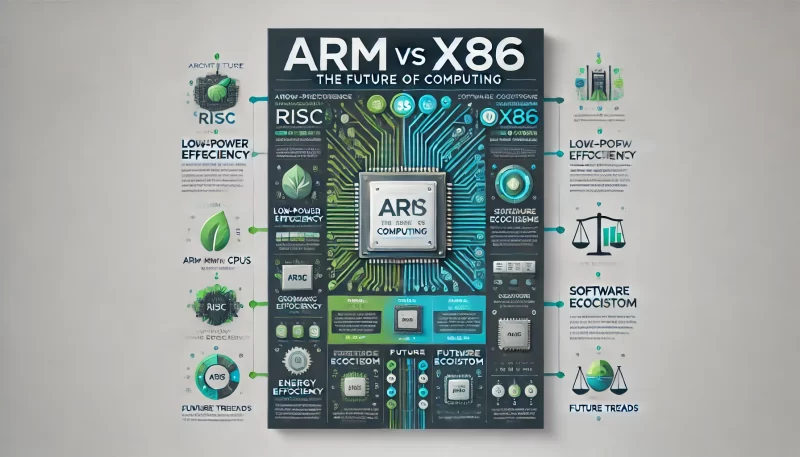ARM CPUs vs. x86 Processors: The Future of Computing?
As the world of computing evolves, the rivalry between ARM CPUs vs. x86 Processors from Intel and AMD has intensified. With ARM’s architecture gaining traction in a variety of devices—from smartphones to servers—the question arises: Are ARM CPUs the future of computing? In this blog, we’ll explore the fundamental differences between ARM and x86 architectures, their respective advantages, and the current performance landscape.
We’ll also evaluate whether ARM CPUs could replace traditional x86 processors in the long run.
ARM CPUs vs. x86 Processors – Table of Contents
- What are ARM CPUs?
- What is RISC Architecture?
- What is x86 Architecture?
- Key Differences: ARM vs. x86
- Performance: ARM vs. Intel and AMD CPUs
- Why ARM CPUs are Growing in Popularity
- Benchmarks: ARM vs. x86 in Real-World Scenarios
- The Future of ARM CPUs
- Will ARM Replace x86?
1. What Are ARM CPUs?

ARM CPUs are processors based on the ARM architecture, developed by Arm Holdings. Unlike x86, ARM designs are focused on efficiency and are often licensed to manufacturers such as Apple, Qualcomm, and Samsung. ARM processors dominate mobile devices, embedded systems, and increasingly, laptops and servers.
Key features of ARM CPUs:
- Power Efficiency: Designed to consume less power, making them ideal for mobile and battery-powered devices.
- Scalability: Widely used in everything from low-power IoT devices to high-performance servers.
- License Model: Arm Holdings licenses its designs, enabling innovation by hardware manufacturers.
2. What is RISC Architecture?
ARM processors use RISC (Reduced Instruction Set Computer) architecture. RISC is a design philosophy emphasizing simplicity and efficiency, focusing on a limited set of highly optimized instructions.

Characteristics of RISC Architecture:
- Simplified Instruction Set: Executes fewer, simpler instructions per cycle.
- Energy Efficiency: The simplicity of RISC designs leads to lower power consumption.
- Parallelism: High instruction throughput due to streamlined execution.
ARM’s RISC design contrasts sharply with the CISC (Complex Instruction Set Computer) model used by x86 processors.
- Joystick / HOTAS – AMAZON.com
- Rudder Pedals – AMAZON.com
- Throttle Quadrant – AMAZON.com
- Gaming Chair – AMAZON.com
- VR Headset – AMAZON.com
3. What is x86 Architecture?

The x86 architecture, pioneered by Intel, has been the backbone of personal computers and servers for decades. It follows the CISC (Complex Instruction Set Computer) philosophy, emphasizing compatibility and the ability to handle complex instructions in fewer cycles.
Characteristics of x86 Architecture:
- Complex Instruction Set: Supports a wide array of instructions, enabling versatile and powerful computation.
- Legacy Support: Designed to run decades-old software alongside modern applications.
- High Performance: Optimized for workloads that require extensive computation.
However, this complexity often leads to higher power consumption and increased heat generation compared to RISC-based architectures like ARM.
4. Key Differences: ARM vs. x86
Here are the primary distinctions between ARM and x86 architectures:
| Feature | ARM | x86 |
|---|---|---|
| Architecture | RISC | CISC |
| Instruction Set | Simplified, streamlined | Complex, extensive |
| Power Efficiency | Highly efficient | Higher power consumption |
| Performance Focus | Scalable, energy-efficient | Raw performance |
| Market Presence | Mobile, IoT, emerging in PCs and servers | PCs, servers, high-performance computing |
| Software Support | Limited legacy support | Extensive legacy software |
5. Performance: ARM vs. Intel and AMD CPUs

ARM CPUs are closing the performance gap with x86 processors, particularly in high-performance scenarios. For instance, Apple’s M-series chips (M1, M2, and M3) have demonstrated that ARM-based processors can compete directly with Intel and AMD in terms of processing power, energy efficiency, and thermal management.
Performance Strengths of ARM CPUs:
- Efficiency: ARM processors deliver excellent performance-per-watt, making them ideal for mobile and lightweight laptops.
- Thermal Management: Generate less heat, reducing the need for complex cooling solutions.
- Integration: Often include tightly integrated components like GPUs and neural engines for specific tasks.
Performance Strengths of x86 CPUs:
- Raw Power: Designed for heavy-duty tasks like gaming, 3D rendering, and data centers.
- Software Ecosystem: Broad compatibility with existing applications and operating systems.
- Multicore Performance: Excel in tasks requiring high core counts and thread handling.

6. Why ARM CPUs Are Growing in Popularity
Several trends are driving the adoption of ARM CPUs in devices traditionally dominated by x86 processors:
- Mobile-First Development: ARM’s dominance in smartphones has paved the way for broader adoption in laptops and desktops.
- Customizability: Companies like Apple and Amazon are creating custom ARM designs optimized for their specific needs.
- Power Efficiency: As devices prioritize battery life and sustainability, ARM’s energy efficiency becomes a crucial advantage.
- Cloud and Servers: Providers like AWS Graviton leverage ARM for cost-effective, energy-efficient data centers.
7. Benchmarks: ARM vs. x86 in Real-World Scenarios

To illustrate the performance differences between ARM and x86 processors, let’s compare a few scenarios:
Single-Core Performance
Apple’s M2 chip delivers performance on par with Intel’s 12th-gen Core i7 in single-threaded tasks while consuming significantly less power.
Multi-Core Performance
In multi-core tasks, ARM chips like the M2 Pro or AWS Graviton3 compete well against high-end x86 chips, especially in workloads like video editing and server-based processing.
Gaming and High-Performance Computing
x86 CPUs from AMD and Intel remain the preferred choice for gaming due to better GPU compatibility and clock speeds. However, ARM chips are improving in this space.
8. The Future of ARM CPUs

ARM’s Increasing Presence
ARM CPUs are finding their way into diverse applications:
- Laptops: Apple’s M-series MacBooks showcase ARM’s potential in productivity-focused devices.
- Servers: Companies like Amazon and Google are increasingly deploying ARM-based solutions.
- Desktops: Windows on ARM is slowly gaining traction, although software compatibility remains a challenge.
Challenges Ahead
Despite their advantages, ARM CPUs face obstacles:
- Software Ecosystem: Many x86-optimized applications need to be recompiled or emulated on ARM, potentially impacting performance.
- Market Inertia: x86 processors are deeply entrenched in enterprise and gaming markets.
9. Will ARM Replace x86?
The transition from x86 to ARM is likely to be gradual, with both architectures coexisting for the foreseeable future. ARM CPUs will continue to dominate mobile and lightweight devices, while x86 remains strong in gaming, legacy systems, and enterprise servers.
Factors Influencing the Transition:
- Software Portability: As more developers optimize for ARM, adoption will accelerate.
- Efficiency Demands: ARM’s efficiency makes it attractive in a world prioritizing sustainability.
- Innovation: Companies like Apple are driving innovation in ARM-based computing.
Conclusion
ARM CPUs vs. x86 Processors have both proven themselves as a formidable choice between x86 & ARM processors, particularly in efficiency and emerging markets like laptops and servers. While they may not entirely replace Intel and AMD’s offerings, their growing performance capabilities and widespread adoption suggest a bright future. Whether you’re a consumer or an enterprise, ARM CPUs are worth watching as the computing landscape evolves.
It appears even Microsoft is coming on board with it said they are going to make WIndows 11 and beyond ARM capable which says a lot for the new processor on the block. It’s certainly making some inroads and already popular on MAC’s.
- Latest CPU’s Available Now – Amazon.com
- Get a NEW GPU Best Performance – AMAZON.com
- Upgrade RAM Here today – AMAZON.com
- Prebuilt PC Options – AMAZON.com

- ARM’s power efficiency and scalability are unmatched, but x86’s legacy compatibility and raw power still hold significant value.
- Hybrid ecosystems may become the norm, with ARM and x86 processors coexisting across different device categories.
The ARM vs. x86 battle is shaping the future of computing, and we’re just getting started!

Author
Brendon McAliece (Aka Gunnie) is a military veteran with 23 years working on Jet Fighters, their weapons systems and ejection seat/module systems as well as munitions and R&D. Involved with flight simulation since the 1980s, he has flown all the major flight simulators over the years.
He is an Australian expat who has lived in Malaysia, UK, Saudi Arabia and more recently Thailand. He is a multi-lingual blogger who loves to share his life experiences here on LetsFlyVFR.com and DreamingGuitar.com, with his lifestyle and Travel experiences Blog plus his Dreaming Coffee website.
Learn More @ DreamingGuitar.com – DreamingCoffee.com – LetsFlyVFR.com
( HOME – BLOG – SHOP – ABOUT )
As an Amazon affiliate I may benefit from qualifying sales.









